Awrejcewicz J. Numerical Simulations of Physical and Engineering Processes
Подождите немного. Документ загружается.


Adaptive Signal Selection Control Based on Adaptive
FF Control Scheme and Its Applications to Sound Selection Systems
473
Parameters Characters Values Units
Length
p
L
49.999x10
-3
[m]
Width
p
W
24.993x10
-3
[m]
Thichness
p
h
0.4549x10
-3
[m]
Capacitance
p
C
298.200x10
3
[F]
Young’s modulus
p
E
6.2x10
10
[N/m
2
]
Strain coefficent
31
d
-266x10
-12
[m/V]
Conversion factor
κ
-9.655x10
-6
[ ()/Nm V⋅ ]
Table 2. Parameters of the piezoelectric ceramics (PZT)
3.1 Modelling of the primary path dynamics P(z)
The primary path dynamics ()Pz is a path from the reference sensor to the error sensor, as
shown in Fig. 2. As mentioned above, if the distance between two plates is set to 34mm and
the sampling frequency is chosen as 50kHz (0.02ms), then it takes 5 sampling instants for the
primary sound to propagate the gap distance. In the case, the primary path dynamics can be
expressed as a simple delay and constant multiplication, described as follows.
5
11
() ,(0 1)Pz pz p
−
=<≤
(2)
Where
1
z
−
means the time delay operator.
3.2 Modelling of the secondary path dynamics G(z)
The secondary path dynamics ()Gz is a path from the control actuator to the error sensor, as
shown in Fig. 2. A dynamic model of
()Gz is described as a transfer function from the
control voltage input for the actuator to the error sensor voltage sensing the vibration of the
2nd plate. So, the modeling of
()Gz needs analysis how the piezoelectric actuator excites
vibration onto the plate by the input voltage and how the piezoelectric sensor detects the
vibration.
The plate's equation of motion is described by a distributed parameter system expressed as
2444
24224
(,,) (,,) (,,) (,,)
(,,),
wxyt wxyt wxyt wxyt
hD Fxyt
txxyy
ρ
∂∂∂∂
+++=
∂∂∂∂∂
(3)
where
(,,)wxyt is the displacement of the plate along z-axis and (,,)Fxyt is the external
force at the position
(,)xy and time
t
, and D is the bending rigidity. The external force
(,,)Fxyt by the piezoelectric actuator as the moment is expressed as
22
22
(,,) (,,)
(,,) ,
M
xyt Mxyt
Fxyt
xy
∂∂
=+
∂∂
(4)
where
(,,)
M
xyt is the moment at the position (,)xy and time t . Thus, the equation of
motion is rewritten as

Numerical Simulations of Physical and Engineering Processes
474
2 444
24224
22
22
(,,) (,,) (,,) (,,)
(,,) (,,)
.
wxyt wxyt wxyt wxyt
hD
txxyy
M
xyt Mxyt
xy
ρ
∂∂∂∂
+++
∂∂∂∂∂
∂∂
=+
∂∂
(5)
Besides, the moment can be expressed by using the actuator voltage input
()
a
vt
as
(,,) (),
ai
M
xyt v t
κ
=
(6)
where
κ
is defined by (1), and the subscript i denotes the actuator number in a multi-
channel case using multiple actuators.
On the other hand, the piezoelectric sensor generates voltage by its bending deformation,
described as
()
31
00
() ,
ba
pp
sj x y
p
dEW
v t dxdy
C
εε
=+
(7)
where ( )
sj
vt is the sensor voltage and subscript j means the sensor number in a multi-
channel case using multiple sensors, and
ε
is the strain of the piezoelectric sensor
generated by bending of the plate (Moheimani & Fleming, 2005).
As a result, from (5), (6) and (7), it follows that the transfer function
()Gs from the i -th
actuator voltage
()
ai
vt to the j -th sensor voltage ( )
sj
vt is given by
()
()
()
()
31
222
1
00
()
()
()
2
(,) 2 ,
sj
ai
pp p
kj kj ki ki
ba
p
k
kkkk
Vs
Gs
Vs
h
dEW h
Ch
W x y dxdy s s
κ
ρ
ςω ω
∞
=
=
+
Ψ+Φ Ψ+Φ
=− ⋅
++
(8)
where
()
ai
Vs
, ( )
sj
Vs are the Laplace transform of
()
ai
vt
, ( )
sj
vt respectively,
(,)
k
Wxy
is the
eigen modal function of the plate, and the subscript k denotes the modal number,
k
ς
,
k
ω
are the damping ratio and eigen frequency of k -th mode respectively, and
Ψ , Φ are
calculated from the modal function at the location of the piezoelectric patches along
x -axis
and y -axis respectively. In adaptive controller design in numerical simulation, we use a
truncated model within 30th modes.
Finally, we obtain a discrete-time FIR model
()Gz
by the impulse invariance method, that
is, by sampling the impulse response of the continuous-time model
()Gs . As a result, ()Gz
is given as an FIR model expression as
0
() ,
g
L
n
n
n
Gz gz
−
=
=
(9)
where
n
g is the impulse response coefficient at n -th sample, and
g
L is the filter length of
FIR model
()Gz .
0
g becomes 0 because the transfer function is strictly proper.
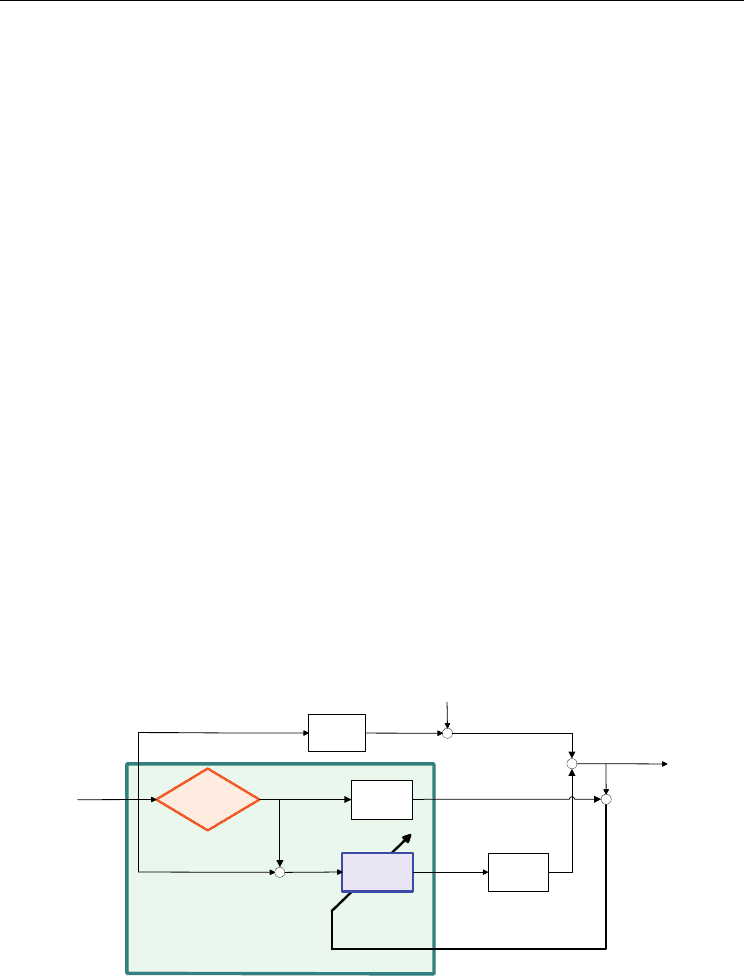
Adaptive Signal Selection Control Based on Adaptive
FF Control Scheme and Its Applications to Sound Selection Systems
475
It should be noticed that the secondary path dynamics (8) involves parameter uncertainties
in its mathematical model, and that is a reason why the adaptive control approach is useful.
4. Design of adaptive Signal Selection Controller
The purpose of the adaptive Signal Selection Controller (SSC)
ˆ
(,)Szk for the SSS in Fig. 2
and Fig. 3 is to transmit only the necessary signals (Necs) and cancel any other unnecessary
noise (Unecs) and the disturbance. In this section, it will be described how to realize the
adaptive SSC
ˆ
(,)
Szk which is composed of an extractor and an adaptive controller.
In the section 4.1, at first, principle of the adaptive SSC is explained.
And in the section 4.2, design of the extractor which is a component of the SSC is shown.
Next, in the section 4.3, design of the adaptive controller which is another component of the
SSC is summarized.
Finally, in the section 4.4, overall structure of the SSC is described.
4.1 Principle of the adaptive Signal Selection Control scheme
Two types of the SSC is introduced; one is Necs-Extraction Controller which transmit only
signals set as Necs as shown in Fig. 4, and the other is Unecs-Canceling Controller which
attenuate only signals set as Unecs as shown in Fig. 5. Results of both controllers are the
same; both controllers transmit Necs and attenuate Unecs selectively, however, the design
concept of each controller is different. When some Necs are known, we choose the Necs-
Extraction Controller and set the Necs to be transmitted. On the other hand, when some
Unecs are known, we choose the Unecs-Canceling Controller and set the Unecs to be
attenuated.
4.1.1 Principle of Necs-Extraction Controller
Fig. 4 shows the schematic diagram of the Necs-Extraction Controller.
+
−
Primary path
dynamics
()zP
()zG
Secondary path
dynamics
Adaptive
controller
+
−
+
−
+
+
()nk
()ak
()bk
+
Necs
Extractor
()ak
()bk
ˆ
()zP
() ()ak bk+
() ()ak bk+
()ek
()
d
yk
()yk
Necs-Extraction
Controller
()Necs k
Disturbance
ˆ
(, )zkK
()uk
ˆ
(, )zkN
Fig. 4. Schematic diagram of the Necs-Extraction Controller (One of the SSC)
As mentioned, the SSC is composed of an extractor and an adaptive controller. In Fig. 4,
()ak is a necessary signal (Necs), and ()bk is an unnecessary noise (Unecs). ()Necs k is the
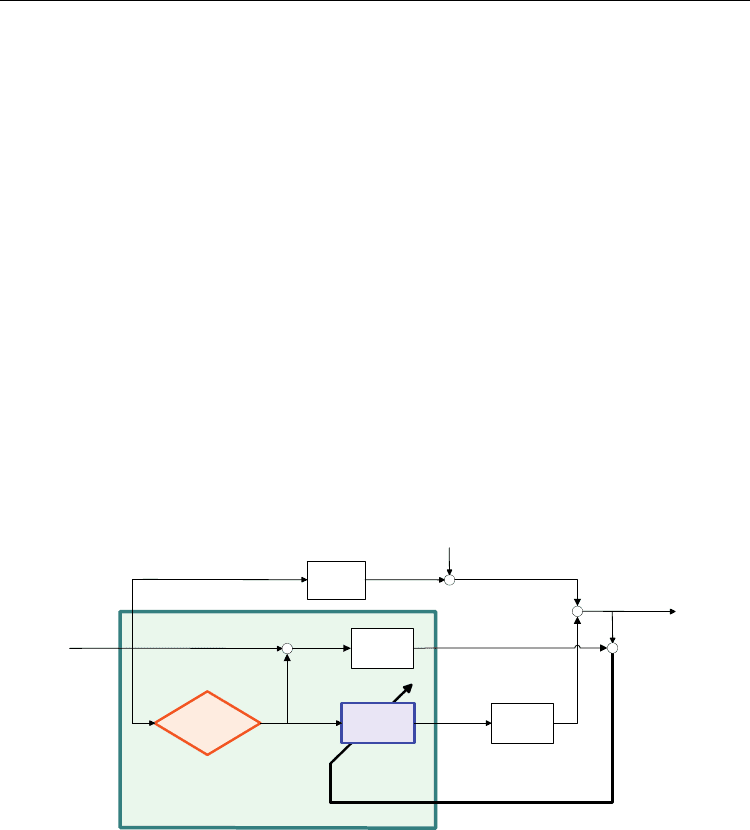
Numerical Simulations of Physical and Engineering Processes
476
transmitted vibration signal sensed by the error sensor on the 2nd plate, ()ek is the error
signal used to adjust the adaptive controller
ˆ
(,)
Kzk , and
ˆ
()Pz is an identified model of the
primary path dynamics
()Pz .
The main operations of the Necs-Extraction Controller
ˆ
(,)
Nzk are summarized as follows;
1.
The extractor extracts only the necessary signal ()ak .
2.
Next, ()ak is subtracted from the input signal to the adaptive controller
ˆ
(,)Kzk .
3.
Then,
ˆ
(,)Kzk works to attenuate only the unnecessary signal ()bk .
4.
Then,
ˆ
(,)Kzk is adjusted to force ()ek into zero.
The above procedure is executed simultaneously in on-line manner.
The canceling error
()ek is expressed as
ˆ
() () ()(),
ek Necsk Pzak=−
(10)
therefore, if
() 0ek → then
ˆ
() ()()Necs k P z a k→ . Thus, if () 0ak → then () 0Necs k → , and if
()ak is the necessary signal then ()Necs k converges to the necessary signal through the
primary path dynamics. That is the principle of the proposed Necs-Extraction Controller
ˆ
(,)
Nzk .
4.1.2 Principle of Unecs-Canceling Controller
Fig. 5 shows the schematic diagram of the Unecs-Canceling Controller.
+
−
Primary path
dynamics
()zP
()zG
Secondary path
dynamics
Adaptive
controller
+
−
+
−
+
+
()nk
()ak
()bk
+
Unecs
Extractor
()ak
()bk
ˆ
()zP
() ()ak bk+
() ()ak bk+
()ek
()
d
yk
()
y
k
Unecs-Canceling
Controller
()Necs k
Disturbance
ˆ
(, )zkK
()uk
ˆ
(, )Uzk
Fig. 5. Schematic diagram of the Unecs-Canceling Controller (One of the SSC)
The principle of the Unecs-Canceling Controller is almost the same as the Necs-Extraction
Controller. Difference between two controllers is how to make input signal to
the adaptive controller
ˆ
(,)
Kzk . In the Necs-Extraction Controller, the input signal ()bk is
made by subtraction of
()ak (which is extracted by the Necs Extractor) from () ()ak bk+ ,
however, in the Unecs-Canceling Controller,
()bk is directly made by the Unecs Extractor.
The main operations of the Unecs-Canceling Controller
ˆ
(,)
Uzk are summarized as follows;
1.
The extractor extracts only the unnecessary signal ()bk .
2.
Next,
ˆ
(,)Kzk works to attenuate only the unnecessary signal ()bk .
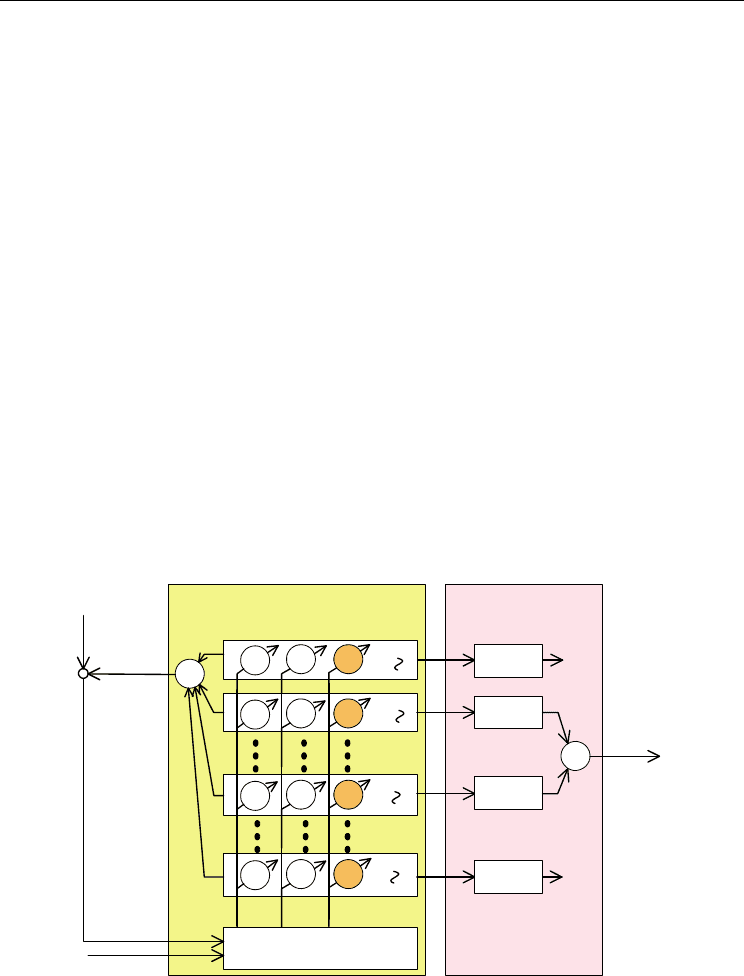
Adaptive Signal Selection Control Based on Adaptive
FF Control Scheme and Its Applications to Sound Selection Systems
477
3. Then,
ˆ
(,)Kzk is adjusted to force ()ek into zero.
The above procedure is executed simultaneously in on-line manner.
The canceling error
()ek is expressed as same as (10), therefore, if () 0ek → then
ˆ
() ()()
Necs k P z a k→ . Thus, whether ()bk is exist or not, ()bk is not transmitted and ()Necs k
converges to the necessary signal through the primary path dynamics. That is the principle
of the proposed Unecs-Canceling Controller
ˆ
(,)
Uzk .
In the following sections, we show how to design the extractor extracting only desired
signal with varying frequencies, and how to update the adaptive controller
ˆ
(,)
Kzk so that
the canceling error can be forced into zero.
4.2 Design of the extractor
The purpose of the extractor is to extract the desired signal by tracking only frequencies of
desired signals even in the presence of frequency variations. It should be noticed that Necs
Extractor and Unecs Extractor is the same; when the desired signal is Necs
()ak , the
extractor is named as Necs Extractor, and when the desired signal is Unecs
()bk , the
extractor is named as Unecs Extractor.
The extractor is a new adaptive filter with tacking ability to selected frequencies, which is
composed of a harmonics synthesizer and a judging synthesizer as shown in Fig. 6. The
harmonics synthesizer estimates frequency and amplitude of all sinusoidal signals in the
input signals. And then, the judging synthesizer judges whether each sinusoidal signal is
necessary or not. Depend on the purpose of the extractor, the judging synthesizer should be
modified.
Variable Step-Size
LMS algorithm
Band-Limited Frequency Tracking
Harmonics Synthesizer
()ek
+
−
Error
signal
Input signal
Cancelling
signal
initial
ˆ
i
α
ˆ
i
β
ˆ
i
ω
1
ˆ
α
1
ˆ
β
1
ˆ
ω
2
ˆ
α
2
ˆ
β
2
ˆ
ω
ˆ
M
α
ˆ
M
β
ˆ
M
ω
1max
ω
1min
ω
2max
ω
2min
ω
maxi
ω
mini
ω
maxM
ω
minM
ω
Judging
Synthesizer
Operation
Operation
Operation
Operation
×
×
Desired
output
0
ω
()dk =
() ()ak bk+
()
c
yk
Fig. 6. Schematic diagram of the extractor
The algorithm for the extractor is based on the DXHS algorithm (Shimada et al, 1999), but
we improve the operation performance by adding new abilities and functions; (i)

Numerical Simulations of Physical and Engineering Processes
478
improvement of readiness for frequency estimation by introduction of a variable step-size
algorithm, (ii) limitation of frequency-estimation bandwidth, and (iii) judging system
whether one signal is necessary or not.
The main procedure of the extractor is summarized as follows;
1.
Estimation of the amplitudes ,
αβ
and frequency
ω
of each sinusoidal signal
composing the input signal
()dk adaptively by using the error signal () () ()
c
ek y k dk=−,
where
()
c
yk is the canceling signal for ()dk which is the sum of all estimated sinusoidal
signal.
2.
Judging whether each estimated sinusoidal signal is necessary or not.
3. Synthesizing only necessary signals to be a desired output.
In the Fig. 6, the Extractor estimates
M
sinusoidal signals, and each estimation bandwidth
is limited from
min
ω
to
max
ω
. Then, 2nd and i th signal are judged to be necessary.
The canceling signal
()
c
y
k is synthesized as
()
1
ˆ
ˆˆ
ˆ
() ()cos( ()) ()sin( ())
M
ciiii
i
y
kkkkk
αβ
=
=Ω+Ω
(11)
ˆˆ ˆ
ˆˆ
() () ( 1) (),( () ),
iiii i
kkT k k kT k
ωωππ
≡Ω =Ω − + − ≤Ω <
(12)
and the amplitudes and frequencies are estimated adaptively by the adaptation laws as;
ˆ
ˆˆ
( 1) () 2 ()cos( ())
ii i
kkekk
ααμ
+= − Ω
(13)
ˆˆ
ˆ
( 1) () 2 ()sin( ())
ii i
kkekk
ββμ
+= − Ω
(14)
ˆ
ˆˆ
ˆˆ
( 1) () 2 () () ()sin( ()) ()cos( ())
ii iiii
kkkTekkkkk
ω
ωωμ α β
+= − ⋅− Ω + Ω
(15)
max max
min max
min min
(())
() () ( () )
(() )
iii
iiiii
iii
k
kk k
k
ωωω
ωωωωω
ωωω
≤
=<<
≤
(16)
(
)
(
)
max min min
()/
() ( ) ,
()/
k
nkN
k
nkN
en N
k
dn N
ω
μμμ μ
ρ
=−
=−
=− +
+
(17)
where
μ
is a constant step size in the adaptation of amplitudes and ()k
ω
μ
is a variable step
size in the adaptation of frequencies given in (17) where
max
μ
and
min
μ
are maximum and
minimum value of step size which are design parameters,
ρ
is a small positive constant
employed to avoid division by zero, and N is the sample number to be used for moving
average.
4.2.1 Necs Extractor for ambulance’s siren sound
In this chapter, we consider the Necs-Extraction Controller which extracts the siren sound of
ambulance. So in this section, design of the judging synthesizer for siren sound is described.

Adaptive Signal Selection Control Based on Adaptive
FF Control Scheme and Its Applications to Sound Selection Systems
479
In Japan the siren signal of an ambulance consists of 960Hz sound (pi) and 770Hz sound
(po), and the two sounds repeat one after the other at 0.65s cycle. The two frequencies
change by the Doppler effect from 900Hz to 1060Hz for pi and from 700Hz to 850Hz for po
respectively, when the maximum relative speed against an ambulance is 120km/h. We also
consider a situation when another unnecessary noise exists in a band of the varying siren
frequencies, for instance, unnecessary sinusoidal noise with 900Hz.
To judge the siren signal, we use the frequency information mainly and amplitude
information supplementarily. To be more specific, the frequency information used for siren
judgement is as follows;
1.
'pi' is 960Hz sound and 'po' is 770Hz sound.
2.
The two sounds vary in the same ratio by the Doppler effect.
3.
The two sounds alternate in 0.65s cycle.
The judgement flow is given as follows;
1.
Estimate the frequency of likely 'pi' (or 'po').
2.
Calculate the frequency of the alternative, that is, 'po' (or 'pi') by using the Doppler
effect.
3.
If there is a sound 0.65s before whose frequency is a similar one calculated in step 2, it
must be the siren signal.
4.
Output the signals judged as the siren.
By above four steps, the judging synthesizer judges the siren signals.
4.2.2 Unecs extractor for compressor’s motor sound
In this chapter, we consider the Unecs-Canceling Controller which attenuates the rotating
motor’s sound of a compressor. So in this section, design of the judging synthesizer for
compressor’s motor sound is described.
In this case, information of rotation order signal can be used. In the case of using AC servo
motor, rotation orders like target frequency is sent to the motor. Using this target frequency
information, the judging synthesizer can extract only rotating motor sound with tracking to
the rotating frequency variation.
4.3 Design of the adaptive controllers
In the Fig. 4 and Fig. 5, the adaptive controller
ˆ
(,)Kzk needs to update the parameter of the
controller itself so that the canceling error
()ek can be forced into zero.
In this section, four adaptive controllers are introduced and characterized; (i) the filtered-X
LMS controller which is a conventional approach in the adaptive FF control field (Burgess,
1981; Widrow et al, 1982), (ii) the 2-degree-of-freedom filtered-X LMS controller (Kuo, 1996,
1999), (iii) the Virtual Error controller which is proposed by one of the authors before
(Kohno & Sano, 2005; Ohta & Sano, 2004), and (iv) the 2-degree-of-freedom Virtual Error
controller which is also proposed by us before (Okumura & Sano, 2009). The following
section gives summary for these controllers, brief description about controller (i), (ii) and
(iii), and detail information about controller (iv).
4.3.1 Summary for four adaptive controllers
In the fields of ANC and AVC, adaptive feedforward control schemes were adopted due to
excellent performance of noise attenuation. Almost previous works employed various type of
filtered-x (FX) algorithms (Burgess, 1981; Widrow et al, 1982), but they are not stability-assured
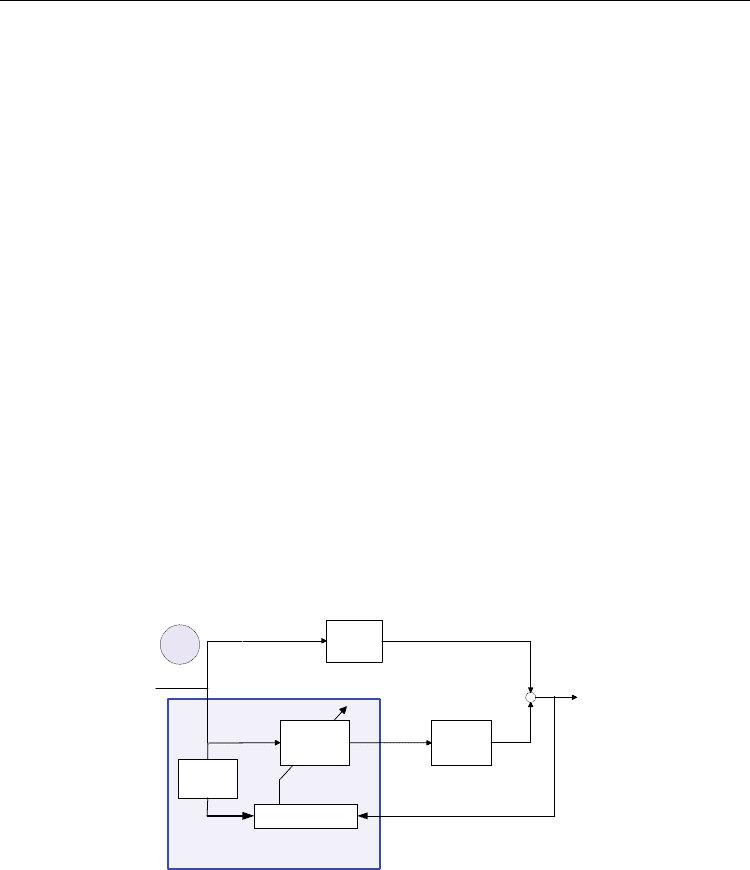
Numerical Simulations of Physical and Engineering Processes
480
since the canceling error is directly used in adaptive algorithms for updating controller
parameters. One of the authors proposed the Virtual Error (VE) approach which does not use
the canceling error directly but a virtual error in the adaptation, and is locally stability-assured
(Kohno & Sano, 2005; Ohta & Sano, 2004). However, since both FX and VE approaches are
used in the feedforward (FF) control, they cannot attenuate the effects of unknown
disturbances to the primary path dynamics, which cannot be sensed by a reference sensor.
To attenuate the disturbance noise in the primary path, feedback (FB) control should be
additionally employed. Previously we proposed a two degree-of-freedom (2DF) control
scheme consisting of an adaptive FF controller and a fixed but robust FB controller
(Okumura et al, 2008), but the approach needs nominal information on the secondary path
dynamics and the performance sometime becomes degraded due to its model uncertainty. A
2DF control scheme consisting of adaptive FF and FB controllers based on 2DF filtered-X
algorithm has also been studied (Kuo, 1996, 1999), but can hardly adjust the two adaptive
controllers simultaneously. So, we proposed a novel VE approach for updating all the
parameters of the both adaptive FF and FB controllers simultaneously in on-line manner,
which is the 2DF Virtual Error controller (Okumura & Sano, 2009).
4.3.2 Filterd-X LMS (FX) controller
Fig. 7 shows block diagram of the filtered-X LMS (FX) controller. And the adaptation law for
the controller parameters is as follows (Burgess, 1981; Widrow et al, 1982). (Meanings of
characters are described in section 4.3.5, so see detail in the section 4.3.5.)
ˆˆ
(1) () ()()()
CCC
kkekGzk
μ
+= +θθ ξ
(18)
+
−
Primary Path
dynamics
Secondary Path
dynamics
Adaptive FF
controller
LMS algorithm
()dk
()
y
k
()
d
y
k
()ek
()Gz
ˆ
()Gz
()
P
z
ˆ
(, )Czk
()uk
()kξ
ˆ
(,)Kzk
FX Controller
Fig. 7. Block diagram of the filtered-X LMS controller
4.3.3 2-degree-of-freedom filtered-X LMS (2DF-FX) controller
Fig. 8 shows block diagram of the 2-degree-of-freedom filtered-X LMS (2DF-FX) controller.
And the adaptation laws for the controller parameters are as follows (Kuo, 1996, 1999).
(Meanings of characters are described in section 4.3.5, so see detail in the section 4.3.5.)
ˆˆ
(1) () ()()()
CCC
kkekGzk
μ
+= +θθ ξ
(19)
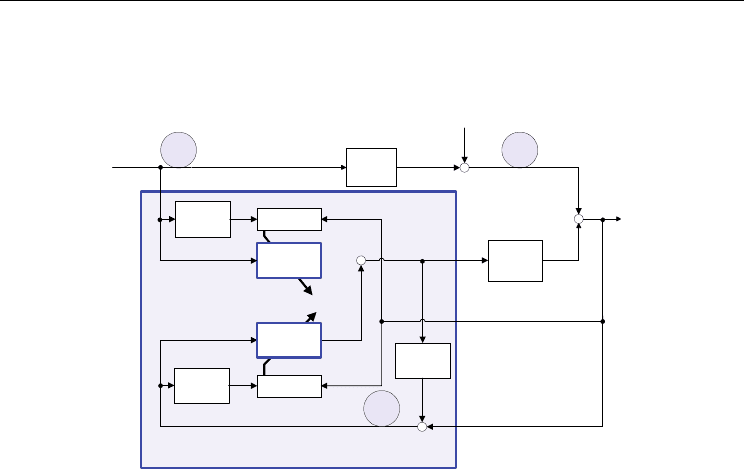
Adaptive Signal Selection Control Based on Adaptive
FF Control Scheme and Its Applications to Sound Selection Systems
481
ˆˆ
(1) () ()()()
BBB
kkekGzk
μ
+= +θθ η
(20)
+
−
Primary Path
dynamics
Secondary Path
dynamics
Adaptive FF
controller
LMS
()dk
()yk
()
d
yk
()ek
()Gz
ˆ
()Gz
()Pz
ˆ
(, )Czk
()uk
()kξ
ˆ
()Gz
ˆ
()Gz
LMS
+
+
Adaptive FB
controller
+
+
2DF-FX Controller
ˆ
(, )
B
zk
ˆ
()
d
yk
()kη
ˆ
()kη
()vk
Plant Noise
()nk
+
+
ˆ
(,)Kzk
Fig. 8. Block diagram of the 2-degree-of-freedom filtered-X LMS controller
4.3.4 Virtual Error (VE) controller
Fig. 9 shows block diagram of the Virtual Error (VE) controller. And the adaptation laws for
the controller parameters are as follows (Kohno & Sano, 2005; Ohta & Sano, 2004).
(Meanings of characters are described in section 4.3.5, so see detail in the section 4.3.5.)
ˆˆ
(1) () ()()
DDDA
kkekk
μ
+= +θθ ξ
(21)
ˆˆ
(1) () ()()
HHHA
kkekk
μ
+= +θθ ς
(22)
ˆˆ
(1) () ()()
CCCB
kkekk
μϕ
+= +θθ
(23)
4.3.5 2-degree-of-freedom Virtual Error (2DF-VE) controller
The main purpose of the adaptive controller block
ˆ
(,)Kzk is to force the error signal ()ek
into zero even in the presence of uncertainties in the path dynamics and disturbance. In this
section, we propose a 2-degree-of-freedom virtual error (2DF-VE) approach to update the
parameters of four adaptive filters shown in Fig. 10.
The original version of the virtual error (VE) approach was proposed by one of the authors
(Kohno & Sano, 2005; Ohta & Sano, 2004), but it could not treat with the unknown
disturbance
()nk . In the new VE approach, by introducing the adaptive feedback (FB)
controller
ˆ
(,)Bzk , we can also suppress the disturbance effects by
()nk . Hence this scheme
is referred to as the 2DF-VE algorithm, since it consists of the adaptive feedforward (FF)
controller
ˆ
(,)Czk and the adaptive feedback (FB) controller
ˆ
(,)Bzk .
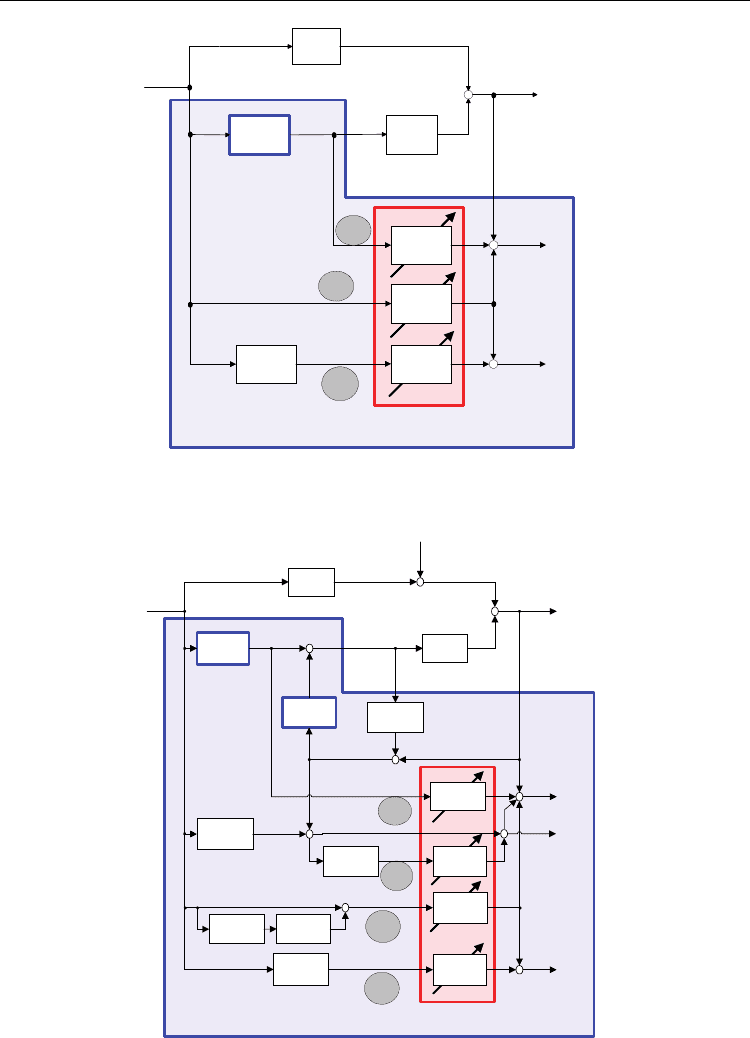
Numerical Simulations of Physical and Engineering Processes
482
+
−
Primary Path
dynamics
Secondary Path
dynamics
Adaptive FF
controller
()dk
()yk
()
d
yk
()ek
()Gz
()Pz
ˆ
(, )Czk
()uk
()kξ
+
−
ˆ
(, )
H
zk
ˆ
(, )Dzk
+
()
A
ek
ˆ
(, )
H
zk
ˆ
(, )Czk
+
−
()
B
ek
()k
ϕ
()kζ
()
x
k
Adaptation
()dk
Virtual Error
Controller
()uk
Virtual
Identification
Error
Virtual
FF Cancelling
Error
ˆ
(,)Kzk
Fig. 9. Block diagram of the Virtual Error controller
+
+
−
−
+
+
−
Primary path
dynamics
Adaptive
FF controller
Secondary path
dynamics
Adaptive
FB controller
−
ˆ
(, )zkB
+
+
+
+
+
+
+
−
−
−
+
+
()kσ
()kδ
()kζ
()
P
yk
()nk
()
d
yk
()ek
()yk
()
A
ek
()
B
ek
()
C
ek
()uk
()vk
ˆ
()
P
yk
ˆ
()nk
ˆ
()
d
y
k
()
s
k
()qk
()
x
k
Cancelling
error
Prediction
error
Virtual
FB cancelling
error
Virtual
FF cancelling
error
Adaptation
2DF Virtual Error
Controller
()uk
Disturbance
ˆ
(, )Hzk
ˆ
(, )Dzk
ˆ
(, )Czk
ˆ
(, )Czk
ˆ
(, )Dzk
ˆ
(, )Hzk
ˆ
(, )Hzk
ˆ
(, )Hzk
ˆ
(, )Hzk
ˆ
(, )
B
zk
()Gz
()
P
z
ˆ
(, )
B
zk
()kφ
ˆ
(, )Kzk
()bk
Fig. 10. Block diagram of the 2-degree-of-freedom Virtual Error controller
